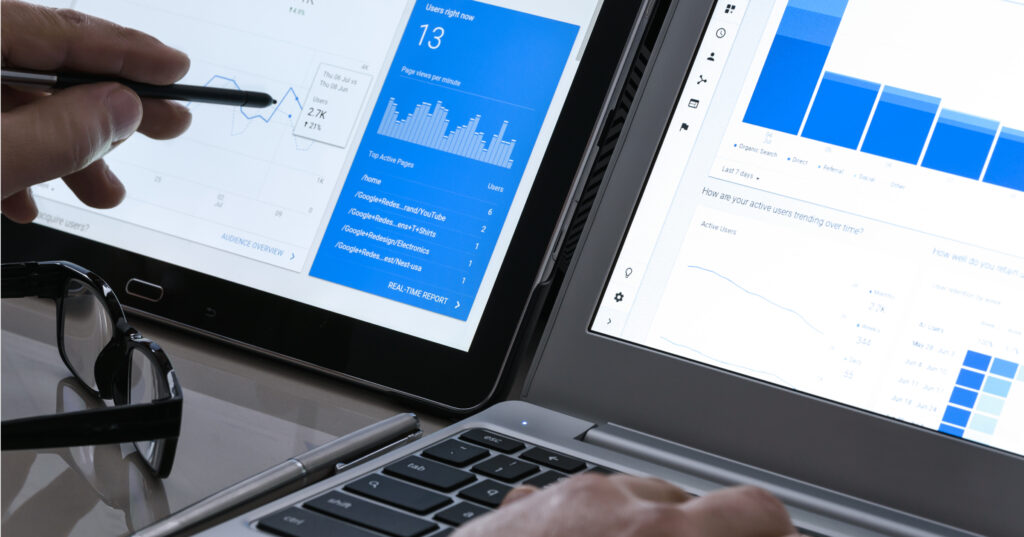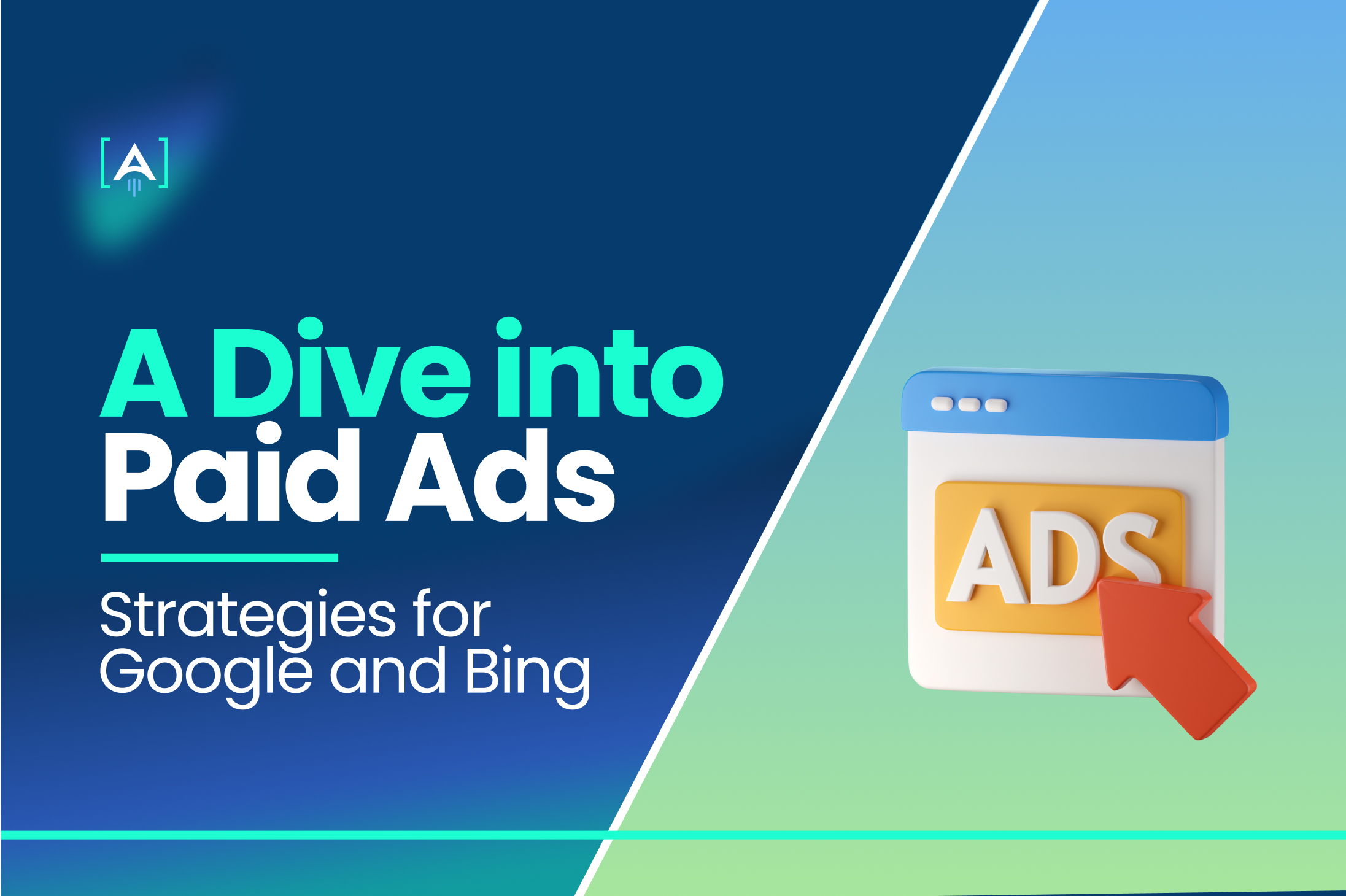In the vast world of the internet, two giants stand tall: Google and Bing. They’re like the main highways of the digital realm, guiding businesses to their potential customers.
But how do they work? How can businesses ride these highways effectively?

Let’s unravel this journey together, step by step, understanding the twists and turns that make these platforms the powerhouses they are with the help of a Google Ads Agency.
Foundations of Digital Advertising Platforms
The Landscape of Google and Bing Ads
Before diving deep, let’s rewind the clock. Google, birthed in 1998, swiftly became synonymous with search.

By the time Microsoft Bing entered the scene in 2009, the landscape was ripe for competition and innovation. Their journeys, while distinct, have shaped the ad industry we see today.
Here’s a quick breakdown:
- Google: Boasting unparalleled reach, Google’s advertising suite is vast and versatile. It’s the go-to for businesses hungry for broad visibility.
- Bing: Offering a fresh perspective, Bing’s tight-knit integration with Microsoft’s ecosystem unveils unique advertising opportunities. And here’s a pro tip: the competition is often lesser, making it a hidden gem for the right advertisers.
Market Metrics: Where Do They Stand?
Numbers speak louder than words, right?
- Google: A titan with 83.49% of the global share. Zoom into the UK, and that number jumps to a staggering 93.69%. The numbers make a statement; Google’s omnipresence is undeniable.
- Bing: Don’t be too quick to sideline Bing. With significant revenue earnings (how does $8,690,000 in Q4 2022 sound?) and marketing campaigns resulting in a 50% traffic boost, it’s an underdog with a bite.
Trend Spotting: Current Ad Waves
Staying updated with trends is paramount. Both Google and Bing have been pioneering novel advertising avenues. From mobile-centric strategies to leveraging AI, the platforms are in a continuous evolution spree. Have you noticed those snazzy new formats on Google or Bing’s LinkedIn profile targeting? Just the tip of the iceberg!
Technological Infrastructure and Capabilities
Algorithm Mysteries Unraveled
The magic behind ad placements? Algorithms. Both platforms operate under their unique ranking factors—decoding them means better ad positioning. While the exact mechanics remain proprietary, we know that relevance, quality, and bid amount play crucial roles.
Mobile vs. Desktop: The Great Debate
Mobile ad spending is on a relentless rise. Both platforms offer tailored solutions for each. But remember, strategies differ as user behavior on a mobile varies drastically from desktop.
Integration & Flexibility
Your tools need to talk to each other. Google and Bing understand this. They both offer seamless third-party integrations, ensuring your advertising campaigns and analytics tools work in harmony.
Diverse Ad Formats
From classic search ads to engaging display ones, both platforms cater to varied advertiser needs. Google, with its Display Network and YouTube affiliations, has a broader canvas. Meanwhile, Bing’s integrations, like Cortana, offer unique touchpoints.
Analytics: Making Sense of the Numbers
Both platforms are data-driven powerhouses. Tools like Google Analytics and Microsoft Clarity help advertisers dissect performance, draw actionable insights, and sharpen strategies.
Financial Aspects of Advertising
- Understanding CPC Dynamics: Google’s extensive reach often means higher CPCs, while Bing, with its lower competition, can offer cost-effective solutions. Balancing between the two can be your winning strategy.
- Budgeting 101: Allocating budgets smartly is half the battle won. Factors like ad formats, target demographics, and seasonal trends should guide your financial strategies.
- ROI: The Ultimate Gauge: Each platform caters to unique demographics, which can influence ROI. Regular monitoring, considering metrics like conversion rates and average order value, is the key.
- Optimizing Ad Spend: Seeking the best bang for your buck? Regular audits, exploring varied ad formats, and machine learning can ensure your investment yields maximum returns.
- Auction-Based Pricing: What It Means for You: The essence? Both platforms operate on a bidding mechanism. Knowing when and how much to bid can make all the difference.
Crafting Effective Ad Campaigns
Imagine piecing together a puzzle. Each piece, no matter how small, contributes to the final picture. Similarly, crafting an effective ad campaign is about getting each element just right.

From choosing the perfect keywords to designing captivating content and ensuring a seamless landing experience, every detail counts. Let’s explore these pieces.
Unraveling the Art of Keyword Research and Selection
At the intersection of the searcher’s intent and business offerings lie keywords. They’re the bridges connecting a user’s query to your solution.
- Decoding Desires: Before the search bar is even clicked, there’s a story. What are users truly seeking? This intent is the compass guiding keyword strategy.
- The Toolkit: Digital tools, when wielded right, can unlock insights into trending keywords, offering a competitive edge.
- Long-Tail: The Unsung Hero: While they might whisper in terms of search volume, they often shout in terms of conversion potential. Longer, more specific, and often more potent.
- The Competitive Arena: Some keywords are battlegrounds. Whether you choose to compete head-on or navigate around, strategy is key.
- Seasons Change, So Should Keywords: Adapting to the rhythmic dance of seasons, holidays, and cultural moments can catapult campaign relevance.
Crafting Compelling Ad Content: The Ingredients
The Backbone: Principles of Persuasion
It’s not just about stating facts. It’s about presenting them in a way that resonates, convinces, and compels.
The Heart: Emotional Triggers
Connect deeper. Dive into feelings and memories, crafting a narrative that touches the heartstrings.
The Direction: Clear Call-to-Action
An ad without direction is a story without an ending. Guide your audience; show them the way.
The Appeal: Incorporating Visual Elements
A splash of color, an impactful image, or a captivating video can be the difference between scroll-past and stop-and-engage.
The Refinement Process: A/B Testing
Crafting is only the beginning. Refining through testing ensures your message is not just heard but also felt.
Landing Page Optimization: A Step-by-Step Guide
- Consistency is King: Ensure that the promise of your ad is reflected on your landing page. Cohesive messaging builds trust.
- Analyze to Optimize: User behavior analytics can be a goldmine. Understand how visitors interact and tweak accordingly.
- Mobile-First Approach: In an increasingly mobile world, responsiveness isn’t optional. It’s a necessity.
- Speed Thrills: Ensure swift page loads. Every additional second can chip away at potential conversions.
- Convert, Don’t Divert: Every element should guide the visitor towards conversion. Clear, intuitive design paired with compelling CTAs can work wonders.
Advanced Targeting Techniques
Unlocking the true potential of your ad campaigns requires a deep understanding and strategic application of targeting. In this dynamic digital landscape, every click, every view, and every interaction holds a story.
Advanced targeting deciphers these stories, aligning your messages with the right audience segments.
Audience segmentation strategies are the crux of personalized advertising. Think of demographics: age, gender, occupation — these factors can help pinpoint a specific segment. But we can delve even deeper.

Behavioral nuances offer insights into user habits, preferences, and interests, further refining the targeting scope. Yet, the game doesn’t stop there.
Remarketing and retargeting bring back those who’ve interacted with your brand but haven’t converted, reigniting their interest. Factor in geographic and time-based targeting, and you’re looking at a strategy that aligns with real-world rhythms, ensuring relevance. And, in our multi-device world, segmenting by device and platform ensures your message fits every screen perfectly.
Now, as you have a well-defined audience, leveraging ad extensions and features can elevate your campaign’s efficacy.
- Get a grip on the available ad extensions: the essential tools in your kit.
- Use site link extensions to guide your audience, letting them explore the different facets of your offering.
- Callout and structured snippet extensions add clarity, emphasizing the key highlights of your product or service.
- Want to catch the eye? Promotion and price extensions are like bright, bold strokes that grab attention.
- And for the mobile-centric world, app and call extensions ensure connectivity on the go.
Finally, when and how you present your ad plays a pivotal role in its success. Ad scheduling and delivery techniques can be likened to delivering a performance. Consider the following key elements:
- Ad Rotation Settings: This determines how often your ad shows up, ensuring that the content remains fresh and relevant to the audience.
- Dayparting: A technique that strategically schedules your ads to appear during times when your audience is most active.
- Frequency Capping: A safeguard against overwhelming your audience, ensuring your brand doesn’t bombard users and overstay its welcome.
- Bid Adjustments Based on Time: This ensures that you’re bidding competitively during crucial moments, maximizing visibility and engagement.
- Global Campaign Scheduling: For those with a worldwide presence, this aligns your campaigns with varying time zones, local events, and specific cultural nuances.
Analyzing and Refining Ad Campaigns
Ever thought of your digital ad campaign as a living, breathing entity? Well, imagine for a moment that after its birth, it needs regular check-ups to ensure it’s growing healthy and strong. Let’s make sense of this together.
You’d want to hear its heartbeat, right? That’s where metrics like the Click-Through Rate (CTR) and Conversion Rate come into play. They let you know your campaign is alive and kicking.
But hey, we all need feedback on how we’re doing! Quality Score and Ad Relevance are like those annual report cards, indicating if our campaign is on the honor roll or needs a bit of tutoring.

Costs, such as the Cost Per Acquisition (CPA) and returns, like the Return on Ad Spend (ROAS), help us balance the budget for our campaign’s college fund.
Now, the growth journey isn’t without its bumps. So, we arm ourselves with tools like A/B testing, use machine learning as our crystal ball, and geographically fine-tune our approach.
And just like regular health check-ups, periodic campaign audits ensure our ad campaign remains in tip-top shape. So, give your campaign the care it deserves!
Diversifying Across Both Platforms
In the digital advertising landscape, Google and Bing stand as distinct yet complementary pillars.

To rely solely on one is to miss out on the potential of the other. Diversifying across both platforms offers advertisers a unique blend of opportunities and challenges.
Benefits of Multi-Platform Advertising
By embracing both Google and Bing, advertisers can tap into:
- Enhanced Reach and Audience Diversity: Expand your audience spectrum from tech-savvy millennials to seasoned professionals.
- Risk Diversification and Backup: Don’t put all your eggs in one basket; having a presence on both platforms cushions against unforeseen changes or challenges on one.
- Platform-Specific Strengths: Each platform boasts unique features and strengths, offering varied tools and approaches to reach your target audience.
- Optimized Budget Allocation: Spread your budget across both platforms to capitalize on each one’s cost-effective strategies and high-ROI opportunities.
- Cross-Platform Synergies: Remarketing strategies can be enhanced by harnessing data and insights from both platforms, creating a cohesive user experience.
Coordinating Campaigns Across Google and Bing
While leveraging both platforms is beneficial, coordination ensures efficiency:
- Synchronized Keyword Strategies: Ensure that your keyword research and targeting strategies align to create a consistent brand message.
- Harmonized Ad Creatives and Messaging: Your brand voice should be recognizable and consistent whether a user encounters you on Google or Bing.
- Event-Based Coordination: Be it seasonal sales, holidays, or global events, ensure campaigns on both platforms are in sync and complementary.
- Shared Analytics Insights: Data from one platform can offer insights to optimize the other, maximizing the overall campaign effectiveness.
- Performance Tracking: Employ cross-platform tools to get a consolidated view of your campaign performance, making adjustments as needed.
Challenges and Overcoming Them
While diversification offers numerous advantages, it’s not without challenges:
- Platform Quirks: Each platform has its nuances. Stay updated and adapt to the unique requirements and best practices of each.
- Budget Management: Diversifying means allocating budgets effectively. Regularly assess spend and performance on each platform to optimize returns.
- KPI Alignment: Ensure that your performance metrics are consistent and comparable across both platforms.
- Efficient Reporting: With data coming in from two sources, streamline your data collection and analysis process for actionable insights.
- Consistent Branding: Your brand’s visual and tonal consistency across platforms reinforces recognition and trust.
Exploring Innovations in Ad Tech
As the digital horizon expands, so does the toolkit for advertisers. The innovations we’re witnessing in ad technology aren’t just evolutionary – they’re revolutionary.

New frontiers are constantly being explored, and the tools at our disposal are becoming sharper, smarter, and more efficient. But what do these innovations look like, and how are they changing the game?
Automation and AI in Advertising
In the realm of advertising, Artificial Intelligence (AI) and automation have emerged as the twin forces propelling campaigns into the future.
Machine Learning Magic
At the heart of this revolution is machine learning, especially evident in ad bidding. Algorithms now analyze vast data sets, making real-time decisions that once took humans hours to compute. The outcome? Faster, more efficient, and often more profitable ad placements.
Content, Auto-Generated
The days of manually crafting every ad content are waning. Automation steps in, creating tailored ad copies that resonate with specific audience segments, maximizing engagement.
Predicting the Future
With predictive analytics, we’re almost reading the future. By assessing past and present campaign data, we can forecast trends, optimize campaigns, and anticipate user behavior.
Chatter with Chatbots
The rise of chatbots and conversational advertising has bridged the gap between brands and consumers. Now, interactions are instant, personalized, and often indistinguishable from human touch.
Audience Segmentation, Supercharged
AI-driven audience segmentation is about precision. It’s the art of identifying micro-segments within your audience, delivering hyper-relevant ads that speak directly to individual preferences and behaviors.
Visual and Video Advertising Evolutions
In an era where content is consumed voraciously, visual and video elements stand out as the showstoppers. Here’s a snapshot of this vivid landscape:
From the ever-evolving video ad formats that captivate viewers to interactive ads that demand user engagement, the visual domain is dynamic.
Augmented Reality (AR) steps in, blending the real and virtual, offering immersive ad experiences that were once the stuff of sci-fi. But it’s not just about creating content; video SEO Search Engine Optimization) ensures it reaches the right audience, ranking high and shining bright.
And the cherry on top? Crafting narratives within video ads that don’t just sell but tell a compelling story, forging a deeper connection with viewers.
Voice Tracking and Emerging Ad Frontiers
Step into the future of paid advertising, where voice commands and innovative platforms are rewriting the rulebook.
The rise of voice search has changed the game. It’s not just about typing queries anymore; it’s about asking them out loud. This shift means content must be adapted and fine-tuned to be voice-search-friendly.
But there’s more. Smart speakers like Alexa or Google Home and voice assistants on our phones are becoming key players. They require tailored content strategies designed to engage users in conversation rather than just providing information.
And as tech wearables—think smartwatches or fitness bands—become common, they open up new ad avenues. These devices, worn throughout the day, offer unique touchpoints to deliver personalized advertising experiences.
Yet, amidst all this tech talk, the core of online advertising remains context. Contextual and ambient ads might be less flashy, but they shine in their own right. They align with users’ surroundings and activities, making them feel less like ads and more like natural content.
Last but not least, the Internet of Things (IoT) is weaving digital threads through our everyday objects. From fridges to cars, the opportunities for innovative ad delivery are expansive.
In the ever-evolving world of ad tech, one thing’s for sure: innovation waits for no one. It’s a race, and with the right strategies, you’re poised not just to compete but to lead.
Tools for Ad Campaign Management
Crafting a compelling ad campaign is akin to assembling a complex watch; each cog, when placed correctly, ensures time is told perfectly. The right tools are pivotal in this assembly, offering precision and synergy.

Essential Tools for Campaign Creation
- Unlocking Keywords: With tools like Google’s Keyword Planner, delve deep into the phrases and terms your audience actively seeks.
- The Art of Ad Crafting: Platforms such as Canva allow advertisers to bring their vision to life, creating visual content that resonates.
- Perfecting the Landing: Your audience’s next stop after the ad is crucial. With Unbounce, you can craft landing pages that not only attract but also engage.
- A Sneak Peek with Mockups: Before a grand launch, get a preview of how your ad fits into the digital landscape.
- Synergy through Collaboration: Keeping a team aligned is essential. Tools like Slack ensure everyone is on the same page, working towards a unified goal.
Analytics and Performance Tracking Tools
- The Campaign’s Pulse: Platforms like Google Analytics provide comprehensive insights, allowing marketers to gauge their campaign’s heartbeat and adapt strategies in real-time.
- Mapping the User Journey: Tools such as Hotjar offer detailed user behavior insights, from heatmaps to conversion funnel analysis.
- Peer into the Competition: With SEMrush, not only can you get a deep dive into your performance metrics, but also gain valuable insights into what your competitors are up to.
- Forecasting the Future: Leveraging the power of AI, predictive analytics tools shape strategies, pre-empting future trends and audience behaviors.
Mastering the Digital Ad Landscape: Your Roadmap to Success

In the dynamic world of digital advertising, navigating the terrain requires more than just intent; it demands strategy, insight, and the right set of tools. And while the landscape evolves, with the right approach, you’re not just adapting; you’re leading the change.
Embrace the journey, harness the tools, and sculpt campaigns that leave an indelible mark. Here’s to crafting not just ads but experiences, to making every click count every impression memorable.
Dive in, and let your legacy in the digital ad realm begin!

